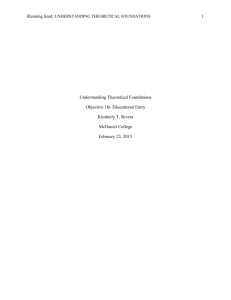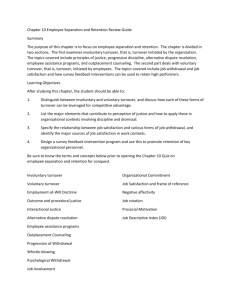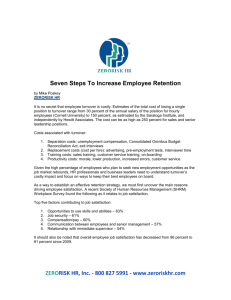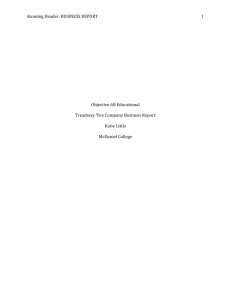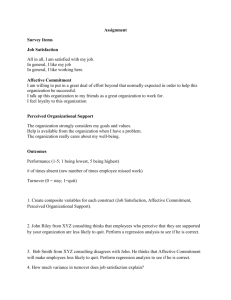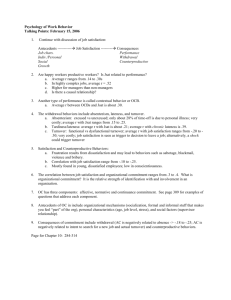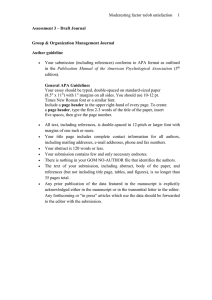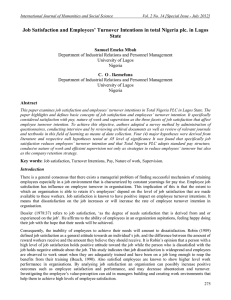Objective #5 – Becoming a Change Agent
advertisement
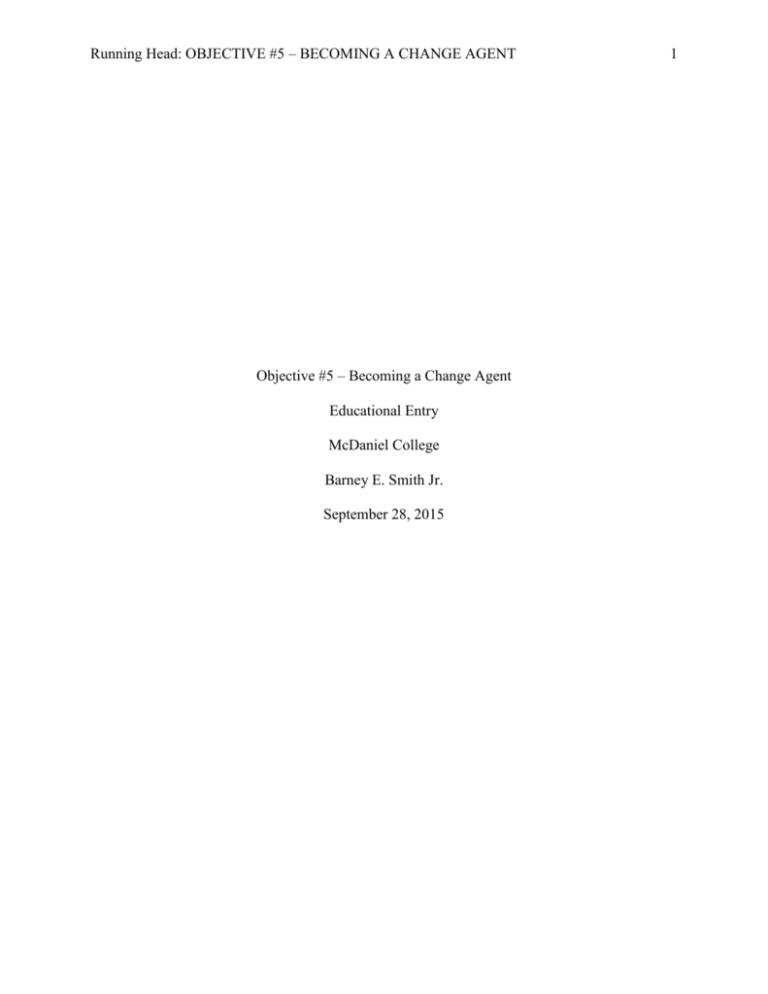
Running Head: OBJECTIVE #5 – BECOMING A CHANGE AGENT Objective #5 – Becoming a Change Agent Educational Entry McDaniel College Barney E. Smith Jr. September 28, 2015 1 OBJECTIVE #5- BECOMING A CHANGE AGENT 2 Objective #5 – Becoming a Change Agent Educational Entry Coaching, feedback, and negotiation are interpersonal skills that enable HR personnel to assist individuals and organizations accomplish strategic goals, particularly in the area of changes in behaviors or structures. This entry is the educational entry demonstrating competence in the area of becoming a change agent. The case study was developed in order to identify specific areas in which change must occur, and address these areas through a recommendation. Change management is an ongoing process and is not exclusively related to major organizational changes, due to the ability of smaller changes or needs in the organization to create a change atmosphere that must be mitigated and managed. The following case elaborates on these areas and is followed by a summary of the importance of change agents in today’s HR departments. The Treadway Tire Company Case The Treadway Tire Company case included components of job dissatisfaction and high turnover at the Lima Tire Plant. Developing change and improving upon value in the human resources utilized in the Lima plant, required a thorough understanding of the current conditions. This included an evaluation of number of employees, current work hours, needs of that plant by the organization, structure of leadership, and more. All of these were carefully considered during the work in order to conclude with recommendations for the organization. Numerous factors contribute to job satisfaction, pay and workloads are included. In the case of Treadway’s Lima plant, the current work schedule included 12-hour shifts and heavy workloads, as this particular plant had to compensate for the closing of an outdated factory. While the overall success of this plant was expected to be maximum production, because the factory would operate 24-hours a day and utilize four rotating shifts. One method of analyzing OBJECTIVE #5- BECOMING A CHANGE AGENT 3 the current employee satisfaction was to develop research, questionnaires for employees, to evaluate if the workers were satisfied with their pay and benefits, which would also allow for an evaluation of worked hours in compared to the pay and benefits. The importance of this particular plant made it crucial to address the needs of employees and assist in creating the best atmosphere for retaining talent. Turnover contributes to the expenses of an organization by increasing costs of hiring, training, and time-to-productivity of the new employee. In addition, turnover can create a negative atmosphere, decreasing employee morale, and becoming a repeating cycle. One concern was regarding how the plant’s leadership contributed to the turnover, or their personal efforts in managing the problems that may be associated with the turnover and decreased job satisfaction. In the Lima plant, employee concerns were not perceived as being important to current human resources personnel. Additionally, there was a lack of motivation in understanding or managing the problem overall. These two primary areas required that the recommendation be to first retrain and organize the human resource department to be more dedicated to the needs of the employees through the use of the proper tools and correct methods to solve issues discovered. In addition, the recommendation included a development of job satisfaction and turnover tools for assessing and addressing the problems. Finally, the recommendations addressed the needs of leaders to have the proper training and tools to be effective in evaluating employee needs. Employees are the most important asset in managing production within a plant. Understanding how to address their needs requires managers and supervisors to have training that provides a solid foundation for effective leadership. OBJECTIVE #5- BECOMING A CHANGE AGENT 4 Demonstration of Becoming a Change Agent The focus of this artifact was to determine the needs of the organization in making changes to the high turnover rates and low job satisfaction of employees at the Lima plant. Effective change is managed by HR teams when they are focused on working with leadership to accomplish the goals of the organization as well as meeting the needs of employees (Long, Wan Ismail, & Amin, 2013). Change occurs at many levels within an organization, and often begins with assessing the need for change. For example, in the case of Treadway Tires, the assessment process included numerous factors, including the strategic value of the plant and the history that lead to the current design of the facility. When HR teams work with leaders to understand the strategic importance or need for change, meeting the needs of the organization and employees becomes easier and more effective. This educational artifact focused on all areas of assessment of needs and proposed a recommended plan-of-action to resolve and change these problems. Employees are not only influenced by the pay and benefits of their performance, but also by the behaviors and attitudes of their leaders (Della Sala, et al., 2013; Ruiz-Palomino, Sáez-Martínez, & Martínez-Cañas, 2013). This area was included in the artifact, demonstrated by the design of leader training and mentoring that were included in the recommendations. Additionally, to better understand these specific areas, HR team members were recommended to receive training and apply tools that will evaluate employee needs and feelings. Finally, Conner (2014) states that HR is an important tool for strategic change management, one which can increase the ROI and accomplish the critical changes necessary in the organization. HR acts as a source of important and valuable information and assessment that is necessary in making changes, which is what was critical in the recommendations for Treadway OBJECTIVE #5- BECOMING A CHANGE AGENT 5 Tires. Understanding needs, critical aspects of the change, and how the change will influence leaders, employees, and the organization, is important to the decision to implement change. Achieving the goal of decreasing turnover rates and improving upon job satisfaction requires the organization to undergo changes that do not negatively influence productivity or performance levels, but still increases value to employees. These goals can be achieved when HR implements assessment focused strategic management of key resources that provide employees and leaders with the tools that are most effective for managing the needs of the organization. Conclusion Human resources Departments are an effective part of organizational leadership and structure by providing the necessary source and mediation for effectively managing the most important part of the organization – human resources. Employees, including leaders, need support in a way that improves upon their experiences and both instigate and support changes that improve upon the success of the organization as a whole. This artifact demonstrates my individual educational knowledge of how change must be managed in order to support the needs of both, the organization and the employees, in order to affect the outcomes productively. All organizations experience change, and this knowledge benefits my future position within HR. OBJECTIVE #5- BECOMING A CHANGE AGENT 6 References Conner, D. (2014). The HR Executive as a Strategic Resource: Identifying and Supporting Major Change Endeavors. People & Strategy, 37(1), 18-22. Della Sala, M. R., Klar, H. W., Lindle, J. C., Reese, K. L., Knoeppel, R. C., Campbell, M., & Buskey, F. C. (2013). Implementing a cross-district principal mentoring program: A human resources approach to developing midcareer principals' leadership capacities. Journal Of School Public Relations, 34(4), 162-192. Long, C. S., Wan Ismail, W. K., & Amin, S. M. (2013). The role of change agent as mediator in the relationship between HR competencies and organizational performance. International Journal Of Human Resource Management, 24(10), 2019-2033. Ruiz-Palomino, P., Sáez-Martínez, F., & Martínez-Cañas, R. (2013). Understanding pay satisfaction: Effects of supervisor ethical leadership on job motivating potential influence. Journal Of Business Ethics, 118(1), 31-43.

